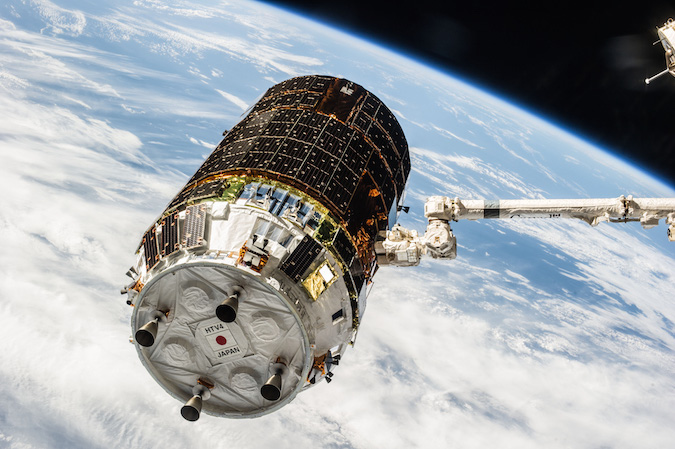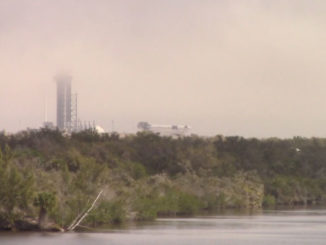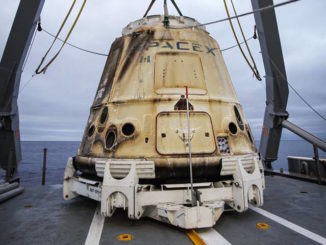
Japan’s H-2 Transfer Vehicle has accomplished five flights to the International Space Station, delivering tons of food, clothing and crew provisions, instruments to look at ozone chemistry and investigate dark matter, and critical hardware to keep the research complex operating.
The HTV was the first visiting spacecraft specifically designed for servicing the space station — NASA’s space shuttles and Russia’s Soyuz and Progress spaceships had flown before.
The Japan Aerospace Exploration Agency pays for its share of the space station’s common operating costs through cargo delivery services on HTV missions.
JAXA has nicknamed the HTV as Kounotori, which translates as white stork in English.
Japan has nine HTV missions planned — three more after Friday’s launch — then a next-generation cargo ship known as HTV-X will pick up JAXA’s resupply duties in 2021.
The HTV stretches 32 feet (9.8 meters) long, with power-generating solar cells mounted to the outside of the spacecraft’s main body. Shaped like a barrel and covered in blue solar cells and bright orange insulation, its diameter is around 14.4 feet (4.4 meters), the right size to fit snugly inside the nose fairing of an H-2B rocket.
JAXA and Mitsubishi Heavy Industries developed the H-2B rocket specially for HTV launches.
The first HTV mission took off to the space station from the Tanegashima Space Center in September 2009, followed by subsequent Japanese resupply flights in 2011, 2012, 2013 and 2015. Once their deliveries are complete, the HTVs depart the station and head for destructive plunges back into Earth’s atmosphere, disposing of trash and other unneeded items.
Details on the HTV missions to date are below, with links to our previous mission coverage.
- Launch: Sept. 11, 2009, at 1701:46 GMT (1:01:46 p.m. EDT)
- ISS Capture: Sept. 17, 2009, at 1947 GMT (3:47 p.m. EDT)
- ISS Departure: Oct. 30, 2009, at 1732 GMT (1:32 p.m. EDT)
- Re-entry: Nov. 1, 2009, at 2126 GMT (4:26 p.m. EST)
- Cargo Delivered: 7,366 pounds (3,341 kilograms)
- Launch: Jan. 22, 2011, at 0537:57 GMT (12:37:57 a.m. EST)
- ISS Capture: Jan. 27, 2011, at 1141 GMT (6:41 a.m. EST)
- ISS Departure: March 28, 2011, at 1546 GMT (11:46 a.m. EDT)
- Re-entry: March 30, 2011, at 0309 GMT (11:09 p.m. EDT on March 29)
- Cargo Delivered: 8,498 pounds (3,854 kilograms)
- Launch: July 21, 2012, at 0206:18 GMT (10:06:18 p.m. EDT)
- ISS Capture: July 27, 2012, at 1223 GMT (8:23 a.m. EDT)
- ISS Departure: Sept. 12, 2012, at 1550 GMT (11:50 a.m. EDT)
- Re-entry: Sept. 14, 2012, at 0527 GMT (1:27 a.m. EDT)
- Cargo Delivered: Approximately 10,150 pounds (4,600 kilograms)
- Launch: Aug. 3, 2013, at 1948:46 GMT (3:48:46 p.m. EDT)
- ISS Capture: Aug. 9, 2013, at 1122 GMT (7:22 a.m. EDT)
- ISS Departure: Sept. 4, 2013, at 1620 GMT (12:20 p.m. EDT)
- Re-entry: Sept. 7, 2013, at 0637 GMT (2:37 a.m. EDT)
- Cargo Delivered: Approximately 11,900 pounds (5,400 kilograms)
- Launch: Aug. 19, 2015, at 1150:49 GMT (7:50:49 a.m. EDT)
- ISS Capture: Aug. 24, 2015, at 1028 GMT (6:28 a.m. EDT)
- ISS Departure: Sept. 28, 2015, at 1653 GMT (12:53 p.m. EDT)
- Re-entry: Sept. 29, 2015, at 2033 GMT (4:33 p.m. EDT)
- Cargo Delivered: Approximately 9,500 pounds (4,300 kilograms)
Email the author.
Follow Stephen Clark on Twitter: @StephenClark1.



